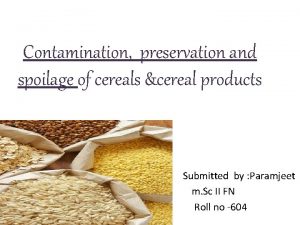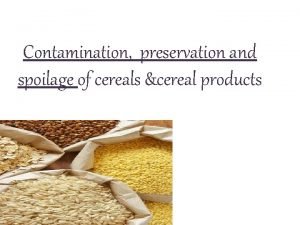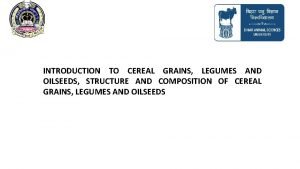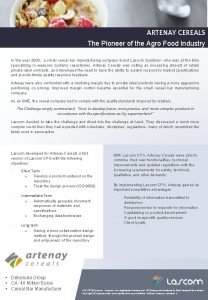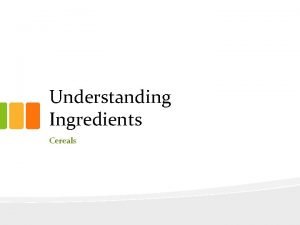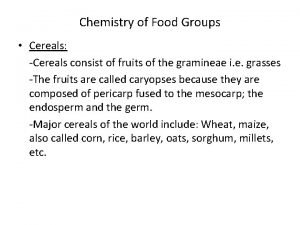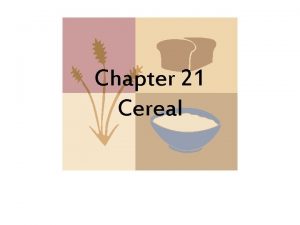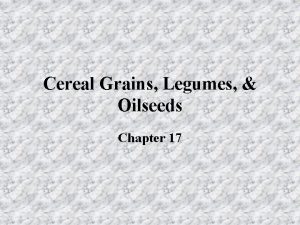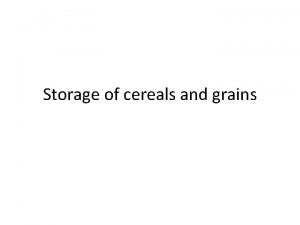Cereals Major Cereals True cereal All cereals are











- Slides: 11

Cereals

Major Cereals • True cereal: All cereals are members of the grass family, Gramineae, and are similar in possessing the characteristic fruit of that family, the karyopsis. • In this fruit the wall of the seed is fused with the ripening ovary wall to form the husk. • There are six true cereals in the world today, which are Wheat, Rye, Rice, Oats and maize. • The millets, sorghums and even buckwheat are often referred to as cereals, but they belong to a different classification. • Cereals contain a higher percentage of carbohydrates than any other food plants as well as a considerable amount of protein and some fats. There are even vitamins present.

Wheat • There are some indications that highlands in Syria and Palestine might be the place of origin, but the Central Asian plateau and the Tigris and Euphrates valleys might be included. • Archeological evidence indicates that wheat had already been cultivated by earlier than 4, 000 B. C. • Kinds of Wheat • Eight principal kinds of wheat were differentiated as species by some taxonomists: einkorn, Polish wheat, emmer, spelt common wheat, club wheat durum wheat and poulard wheat. • Modern classification has been on the basis of chromosome number with the most important species falling into three groups: Diploid (7 pairs) = Triticum monococcum; Tetraploid (14 pairs) = T. dicoccum, T. durum, T. polonicum, T. timopheevi and T. turgidum; Hexaploid (21 pairs) = T. compactum, T. aesticum and T. spelta.

• Einkorn Wheat • Triticum monococcum has been called “Onegrained Wheat” because it has only one fruit in each spikelet. • It is one of the oldest species, dating back to the Stone Age. • It is not used much for baking but primarily for animal feed. • Emmer Wheat • Emmer, Triticum dicoccum, is also known as “Starch Wheat, ” “Rice Wheat, ” or “Two-grained Spelt. ” • It is another very old type that was grown in Babylonia and by all the early Mediterranean civilizations and the lake Dwellers of Europe. • It is used for livestock and breakfast foods and in experimental breeding efforts. Emmer Wheat Einkorn Wheat

• Spelt Wheat • Triticum spelta has been cultivated in the Mediterranean region for centuries and is still grown in Spain. • In North America is has been used as livestock feed. • Polish Wheat • Polish wheat, Triticum polonicum, or “Giant Rye” is species of comparatively recent origin. • It has been grown chiefly in Spain and Italy, Turkestan and Abyssinia. Spelt Wheat

• Poulard Wheat • Also known as “English Wheat” or “River Wheat”, Poulard Wheat, Triticum turgidum, is an old species that probably originated in dry portions of the southern Mediterranean region. • Club Wheat • Triticum compactum (tenax), also called “Dwarf Wheat” or “Hedgehog Wheat” is different from all other species in having short compact heads and small kernels. • Club Wheat is grown chiefly in the mountainous areas of Central Europe, Abyssinia and Turkestan. • The grains are soft and have low protein content, so the flour is not used for bread but rather for pastry flour. Poulard Wheat Club Wheat

• Common Wheat (Bread wheat) • Triticum aestivum is the principal source of bread flour. • Spring wheat is sown in the spring and harvested in late summer. • Winter wheat is planted in the autumn and develops a partial root system before the onset of cold weather.

• Timopheevi Wheat • Triticum timopheevi from Russia is especially resistant to disease and thus has been used in breeding programs with standard varieties.

• Durum Wheat • Triticum durum has a thick head with long stiff beards and large, hard, amber or red grains that are rich in gluten. • This species has been cultivated for a long time in the arid regions of the Old World. • Their high gluten content makes them especially suitable for macaroni, semolina and other types of pastas. • They are mixed with other flour in bread baking. • Red durum wheats are used for livestock. • Timopheevi Wheat • Triticum timopheevi from Russia is especially resistant to disease and thus has been used in breeding programs with standard varieties. Durum Wheat Timopheevi Wheat

Maize • Indian corn or maize, Zea mays, is America’s main contribution to the important group of cereals. • Maize had been thought to have originated in a wild state in the lowlands of southern Mexico and Central America from which it spread to the Andes where its cultivation goes back to prehistoric time. • No cereal is used in so many ways as Maize. • About one-half the crop is used as a food for livestock. • The grain is very nutritious with a high percentage of easily digested carbohydrates, fats and proteins and very few deleterious substances.

• Rice, Oryza sativa, replaces all other cereals in tropical countries as the staff of life and dominates the economic and social structure. • Over half the world’s populations find rice as an indispensable food. • The plant originated somewhere in Southeastern Asia, but it has spread to every warm region of the world. • Rice is used mainly as a food by over half the world’s population. • It needs to be supplemented by legumes or some other food rich in proteins. • A diet of rice and soybeans constitutes the food of millions of people in Asia. • The polished rice, which reaches the world markets, is much less nutritious, but its use is widespread. • Rice starch is widely used in Europe. • Intoxicating beverages are made from rice in Japan and other areas.

